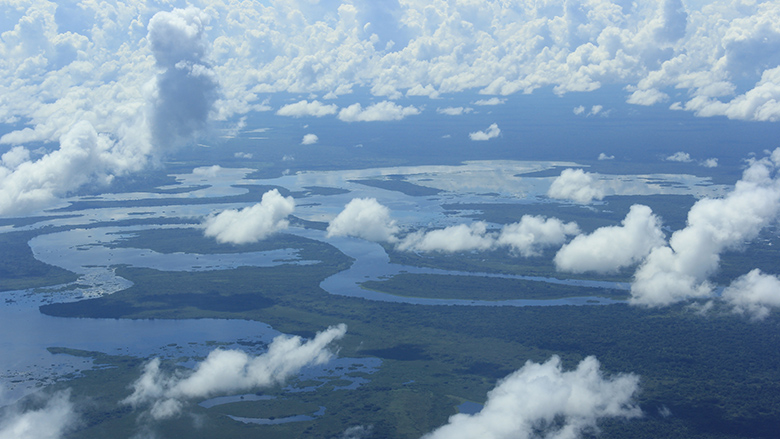
Land tenure for forest peoples, part of the solution for sustainable development
By Gerardo Segura Warnholtz. Originally published by the World Bank.
In Science magazine, earlier this year, researchers revealed that ancient forest peoples of the Amazon helped create much of the imposing forest landscape that the world inherits today.
A growing body of evidence shows that the indigenous peoples and other rural communities who now inhabit these ancestral Amazonian "gardens" continue to be vital to their survival.
Today, as never before, cutting-edge tools and technologies allow ranchers to raise cattle and plant oil palm and soy in poor soils, and investors to build dams and roadways in some of the planet’s most remote forests, opening them to exploration and exploitation.
Like other rural peoples in the forests of Central America, Africa and Southeast Asia, many of the indigenous communities of the Amazon are battling for a way of life![]() that depends on keeping the forests standing. But recent evidence suggests that to successfully resist, or merely influence, the impact of powerful economic forces, indigenous and other forest peoples need rights to their lands that are strong and respected, and investments to support their efforts to manage the lands sustainably.
that depends on keeping the forests standing. But recent evidence suggests that to successfully resist, or merely influence, the impact of powerful economic forces, indigenous and other forest peoples need rights to their lands that are strong and respected, and investments to support their efforts to manage the lands sustainably.
These rights confer benefits, many of which will be discussed at the Conference on Community Land and Resource Rights in Stockholm next week, such as improvements in health and education levels, two key goals of sustainable development, and progress in stopping the destruction of rainforests, which governments, donors and investors have promised to do in committing to slow climate change.
In Stockholm, I’ll share findings from a recent study on “Securing Forest Tenure Rights for Rural Development,” which aims to improve understanding of what it takes to advance forest tenure reforms. The study identifies Latin America as far advanced in recognizing local or customary tenure rights. As of 2013, for example, “approximately 39% of the region’s forestlands were owned or controlled by indigenous peoples and local communities.” The record has made the region a model for those advocating for recognition and enforcement of customary land tenure in Indonesia and the forest nations of sub-Saharan Africa.
Yet the research also revealed that, cumbersome regulations, limited institutional capacity, and powerful competing interests continue to block the realization of legitimate customary rights, contributing to insecurity, conflicts, and displacement among some of the world’s poorest rural inhabitants.
Some of the challenges identified in the study include: clashes between government agencies; overlapping land claims that haunt the titling process; and bureaucratic obstacles that continue to prevent indigenous communities from taking part in decisions about the fate of their lands.
The study concludes, however, that laws alone are not enough to ensure recognition and respect for rights![]() ; and it notes that in some countries, a lack of political will seems to be a factor, despite evidence that governments struggle to control illegal deforestation, while investors have become increasingly wary of the high costs of conflict.
; and it notes that in some countries, a lack of political will seems to be a factor, despite evidence that governments struggle to control illegal deforestation, while investors have become increasingly wary of the high costs of conflict.
A risk analysis released last year by the Rights and Resources Initiative, featuring cases from Africa, Asia and Latin America, revealed a significant link between weak land tenure and financial risk for those investing in extractives and the production of commodities. In more than 60 percent of the cases studied, the authors identified failure to respect customary land rights of minorities and Indigenous Peoples as the primary cause of the dispute; in the forestry sector, this rose to 90 percent. The authors concluded that the local communities are, “principally interested in opportunities to continue traditional livelihoods![]() ,” but this does not mean they lack economic value.
,” but this does not mean they lack economic value.
Another study by the World Resources Institute (WRI) suggests that granting secure tenure to indigenous peoples and other rural communities—just in Latin America—could generate billions of dollars over the next 20 years, based on evidence of their ability to protect forests that are among the most carbon-rich in the world.
Some leaders may fear that granting rights to indigenous peoples and rural communities could damage their countries’ economies. Given the chance to address them directly, we would say that, “rather than damaging your economies, you will instead be pioneers on the edge of a new frontier; your countries will become magnets for investors seeking to serve a growing market for conflict-free, deforestation-free commodities. And that you will become known for choosing the path of sustainable development, in partnership with your own people, many of them with roots in the ancient forests that are so vital to the survival of the planet.”
So, it is time to urge decision makers across the world to embrace land rights for their economic benefits![]() ; to recognize that strengthening land tenure can support the goals of economic development, while addressing the risks of investing in regions where land rights are weak.
; to recognize that strengthening land tenure can support the goals of economic development, while addressing the risks of investing in regions where land rights are weak.
For stories and updates on related activities, follow us on twitter and facebook, or subscribe to our mailing list for regular updates.
Last Updated : 06-16-2024








